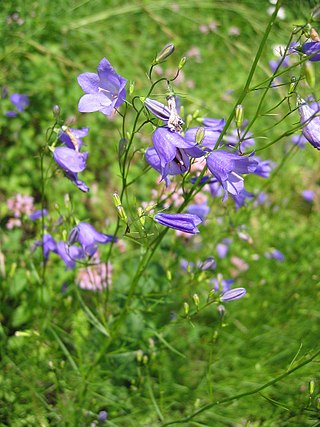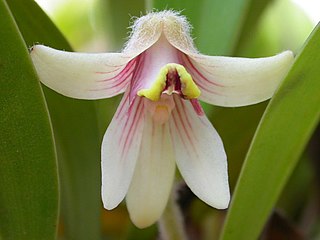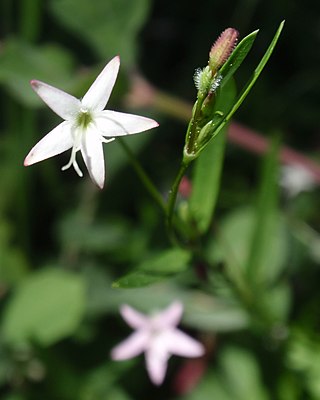
Royal Botanic Gardens, Kew is a non-departmental public body in the United Kingdom sponsored by the Department for Environment, Food and Rural Affairs. An internationally important botanical research and education institution, it employs 1,100 staff. Its board of trustees is chaired by Dame Amelia Fawcett.

In the botanical classification of plants, Aeridinae Pfitzer is a subtribe of the tribe Vandeae whose representatives all have a monopodial growth habit and do not possess pseudobulbs.

Campanula rotundifolia, the harebell, Scottish bluebell, or bluebell of Scotland, is a species of flowering plant in the bellflower family Campanulaceae. This herbaceous perennial is found throughout the temperate regions of the northern hemisphere. In Scotland, it is often known simply as bluebell. It is the floral emblem of Sweden where it is known as small bluebell. It produces its violet-blue, bell-shaped flowers in late summer and autumn.

Cerbera is a genus of evergreen trees or shrubs, native to tropical Asia, Australia, Madagascar, and various islands in the Indian and Pacific Oceans.

Pachycereus is a genus of large cacti native to Central America and Mexico. They form large shrubs or small trees up to 15 m tall, with stout stems up to 1 m in diameter. Pachycereus comes from the ancient Greek παχύς (pachys) meaning "thick" and the Latin cereus meaning "torch".
Phelline is a genus of shrubs and the sole member of the family Phellinaceae, a family of flowering plants endemic to New Caledonia. It is placed in the order Asterales and is related to two other small plant families: Alseuosmiaceae and Argophyllaceae. It contains ten species.

Selenicereus, sometimes known as moonlight cactus, is a genus of epiphytic, lithophytic, and terrestrial cacti, found in Mexico, Central America, the Caribbean and northern South America. The term night-blooming cereus is also sometimes used, but this is also used for many night-blooming cacti, including Epiphyllum and Peniocereus. In 2017, the genus Hylocereus was brought into synonymy with Selenicereus. A number of species of Selenicereus produce fruit that is eaten. The fruit, known as pitaya or pitahaya in Spanish or as dragon fruit, may be collected from the wild or the plants may be cultivated.
William Botting Hemsley was an English botanist and 1909 Victoria Medal of Honour recipient.
George Don was a Scottish botanist and plant collector.

Within the Orchidaceae, Hormidium was originally a subgenus of the genus Epidendrum, but was later raised to a full genus. It is now considered not to be distinct from the genus Prosthechea, of which it is a synonym. Most of the species of Hormidium have been transferred to Prosthechea, although others are now classified in Encyclia, Epidendrum, Homalopetalum, and Lepanthes.

Laeliinae is a Neotropical subtribe including 40 orchid genera, such as Brassavola, Laelia and Cattleya. The genus Epidendrum is the largest within this subtribe, containing about 1500 species. This is followed by the genus Encyclia, with over 120 species.

Pittosporaceae is a family of flowering plants that consists of 200–240 species of trees, shrubs, and lianas in 9 genera. Habitats range from tropical to temperate climates of the Afrotropical, Indomalayan, Oceanian, and Australasian realms. The type genus is Pittosporum Banks ex Gaertn.

Hopea is a genus of plants in the family Dipterocarpaceae. It contains some 113 species, distributed from Sri Lanka and southern India to the Andaman Islands, Myanmar, southern China, and southward throughout Malesia to New Guinea. They are mainly main and subcanopy trees of lowland rainforest, but some species can become also emergent trees, such as Hopea nutans.
Aeridostachya is a genus of orchids.

Campanulorchis is a genus of orchids. It was considered a synonym of the genus Eria, but eventually it has become an accepted name. It is native to Southeast Asia from Hainan to New Guinea.
Dilochiopsis is a genus of orchids. It was previously considered as a synonym of the genus Eria, but eventually it has become an accepted name. At present, there is only one known species, Dilochiopsis scortechinii, endemic to peninsular Malaysia.

Ida, synonym Sudamerlycaste, is a genus of flowering plants in the family Orchidaceae. It consists of approximately 45 species and hybrids. The genus was split off from Lycaste in the early 2000s.

Cymboglossum, synonym Ascidieria, is a genus of flowering plants from the orchid family, Orchidaceae. It is native to Borneo, the Philippines, Sulawesi and Sumatra.

Lumnitzera is an Indo-West Pacific mangrove genus in the family Combretaceae. An English common name is black mangrove. Lumnitzera, named after the German botanist, Stephan Lumnitzer (1750-1806), occurs in mangroves from East Africa to the Western Pacific, and northern Australia.

Kelloggia is a plant genus in the bedstraw and madder family, Rubiaceae. Its two species have a discontinuous distribution; one species is native to Bhutan and China, the other to the western United States.














